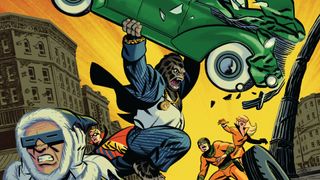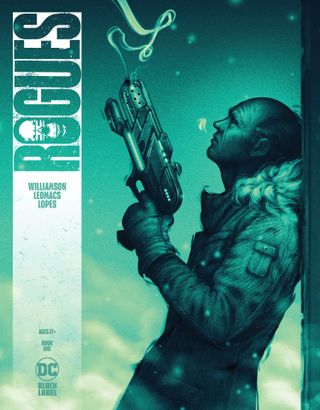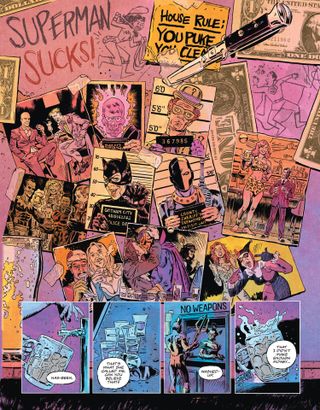Review - DC's Rogues #1 redefines the "old superhero" trope
Joshua Williamson takes time out from Dark Crisis and killing the Justice League for a supervillain heist starring Captain Cold

The Dark Knight Returns. Old Man Logan. TMNT: The Last Ronin. All sparkling examples of one of comics' favorite tropes - aging a popular character and placing them in a new world beyond their control. These stories usually revolve around a superhero, but DC's mature-reader Black Label is changing that. Rogues, a new DC comic by Joshua Williamson, Leomacs, Matheus Lopes, and Hassan Otsmane-Elhaou, finds a supervillain aged up and out of place, as the fan-favorite Flash eponymous Rogues team up one more time for the biggest heist of their lives.
Written by Joshua Williamson
Art by Leomacs
Colors by Matheus Lopes
Lettering by Hassan Otsmane-Elhaou
On sale March 22
'Rama Rating: 8.5/10
We begin with Captain Cold, AKA Leonard Snart. Ten years after the original Rogues disbanded, Snart is working a soul-crushing factory job. It's enough to keep his rent and bar bill paid, so though he might not be happy, he's at least sedated. And then comes one bad day. His jerk of a parole officer makes him late, he has an awful commute, and to top it all off, he hears his bosses mocking the supercriminal he used to be. It's enough to snap him out of his alcoholic haze and put his Absolute Zero technology back together, which he's been keeping in hiding all these years… along with plans for the most daring heist he's ever dreamed up. This is the score that will put him back on top, and free him from his mundane prison. But to pull it off, he'll need his old team back.
Writer Joshua Williamson does an impressive job aging up Snart and the rest of the Rogues, but where his work really shines is in the "world beyond their control" that he's created. It's not the urban warzone of The Dark Knight Returns or the apocalyptic wasteland of Old Man Logan, but it's just as bleak. Williamson makes it clear that the Central City Snart's living in is not the one he once loved.
In one particularly revealing scene, Snart notices a monument on his commute to work that reads, "We built Central City." He smiles, one of the only times he does in the entire book. Then, when he's on his way home, the monument has been destroyed. A temporary sign is up in its place, reading "Central City is on the move." Snart frowns as he realizes that it's true. Central City is moving, and it's leaving him behind.

It's up to artist Leomacs to create the visuals for Snart's uncaring new world, and he pulls it off magnificently. Part of his success comes from the fact that we get snippets of Snart's old, supercriminal life, and we can't help but love them. Leomacs draws the days of the Rogues' past like a coked-up episode of Superfriends, all ornate spandex and impractical costume additions. Then, when the story returns to the "modern" day, all that fun is gone. The Rogues have to commit their first crime in this book in nothing but hoodies. By the end of the book, readers will be wishing for Leomacs's golden days of supervillainy as much as the characters that used to inhabit it.
Speaking of those characters: just because Rogues #1 is mostly about Snart doesn't mean the debut issue doesn't live up to its team name. Villains Trickster, Golden Glider, and Heat Wave are all back and ready to 'rogue,' and their introductions to the story wouldn't be possible without the colorwork of Matheus Lopes.
Snart is collecting his colleagues from all walks of life, and the colors that surround them tell us where they are as the book begins. Lisa Snart, AKA Golden Glider, is a social worker, whose world is as blue as the cases she deals with. James Jesse, AKA Trickster, has become a self-parodying showman under the purple and red lights of a casino showroom. And Mick Rory, AKA Heat Wave, hasn't given up his arsonist past so his world is, well, on fire. Hot oranges and yellows. Thanks to Lopes's work, even readers completely unfamiliar with the characters of this heist story will understand where its crew is coming from.
Comic deals, prizes and latest news
Get the best comic news, insights, opinions, analysis and more!

To be sure, Rogues #1 might be an "old superhero" comic, but it is firmly rooted in the heist genre. Nowhere is that clearer than in the lettering by veteran comic talent Hassan Otsmane-Elhaou.
Just like every good heist flick, we're introduced to the crew by what role they'll be playing in the score, and it's text from Otsmane-Elhaou that tells us those roles. These title cards appear as chapter headings as well as introductions and do wonders for pacing the book and building up the tension toward the crime that takes place at the end. Despite the bleak world in which it takes place, there's some great fun in Rogues #1, and a lot of credit for that should go towards its letterer.
Old superhero stories are popular in comics for a lot of reasons, one of them being that it puts our favorite characters on our level. For the eighty-plus years that they've been around, comic book characters have pretty much universally gained the power to avoid aging, and old superhero stories take that away. Rarely do we get on that level of sameness with our favorite heroes, and even more rarely do we get to experience it with our favorite villains. Hopefully, Rogues #1 will change that fact. It certainly deserves to.
Captain Cold (and other villains from Rogues) figure prominently in any list of the best Flash villains of all time.

Grant DeArmitt is a NYC-based writer and editor who regularly contributes bylines to Newsarama. Grant is a horror aficionado, writing about the genre for Nightmare on Film Street, and has written features, reviews, and interviews for the likes of PanelxPanel and Monkeys Fighting Robots. Grant says he probably isn't a werewolf… but you can never be too careful.
Most Popular



